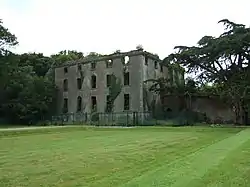Woodstock Estate
Woodstock House and Estate is a derelict Georgian house and estate located near Inistioge, County Kilkenny, Ireland, on the west bank of the River Nore. The Ladies of Llangollen story began here and Mary Tighe died here. The house was destroyed by presumed arson after it was used a billet by the British army. The house is still a ruin but the gardens are open to the public.
| Woodstock House | |
|---|---|
 The ruins of Woodstock House | |
 | |
| General information | |
| Status | Ruin |
| Type | House |
| Architectural style | Palladian |
| Location | Inistioge, County Kilkenny |
| Country | Ireland |
| Current tenants | Coillte and Kilkenny County Council |
| Construction started | 1745 |
| Completed | 1747 |
| Owner | Tighe family |
| Technical details | |
| Material | Kilkenny limestone and sandstone |
| Floor count | 4 |
| Design and construction | |
| Architect(s) | Francis Bindon |
| Developer | Sir William Fownes, 2nd Baronet |
History
Woodstock House is now a ruin. In 1737, William Fownes's grandfather left him over 21,000 acres. William Fownes father, (also) Sir William Fownes, had been the Mayor of Dublin. When the younger William married Elizabeth Ponsonby he received £4,000 as a dowry.[1] With this money William and Sarah built the six bayed three storey Woodstock House in County Kilkenny in 1745-7. They had a child guest named Sarah Ponsonby who was Elizabeth's cousin. When Sarah's adult friend, Lady Eleanor Butler, ran away from home she was hidden in Sarah's room and the housemaid Mary Carryl smuggled in food for her stowaway.[2] Sarah was receiving unwanted attention from Sir William.[3] but eventually they agreed that they could leave Ireland together. They went to Llangollen in Wales where they set up home in a cottage called Plas Newydd. Eleanor and Sarah became the Ladies of Llangollen with Mary Carryl as their lifelong servant.[2]
.jpg.webp)
Over the next forty-five years, Woodstock was the background to a series of dramas that led to the deaths of William, Elisabeth and their son-in-law William Tighe. The Irish poet Mary Tighe died here of tuberculosis in 1820.[4]
The gardens and walks were laid out between 1840 and 1900 by another William Tighe and his wife Lady Louisa Lennox.[5] The gardens contain many exotic plants from Asia and South America, including the Monkey Puzzle tree and the Noble Fir tree which form two of the walks in the gardens,[6] as well as specimens of the Coast Redwood.
In 1921, the property was occupied by the Black and Tans and Auxiliaries, which caused resentment, and then by troops of the Free State Army, who were withdrawn from the premises during the Irish Civil War, on 1 July 1922. The house, left unguarded, was burnt down the next day, and remains a derelict empty shell, overgrown with vegetation. The grounds are being restored by Kilkenny County Council and are open to the public. In the grounds, near the river, is a shooting lodge called the Red House.
In 1978 the estate hosted the Irish Jamboree, marking seventy years of Scouting in Ireland. The celebrations were attended by almost 10,000 Scouts from around the world and they were opened by President Patrick Hillery.
References
- "The Tighe Family & Woodstock Estate". www.askaboutireland.ie. Retrieved 24 March 2020.
- "Carryl, Mary (d. 1809), servant and friend of the Ladies of Llangollen". Oxford Dictionary of National Biography (online ed.). Oxford University Press. 2004. doi:10.1093/ref:odnb/48928. Retrieved 24 March 2020. (Subscription or UK public library membership required.)
- "Butler, Lady (Charlotte) Eleanor (1739–1829), elder of the two Ladies of Llangollen". Oxford Dictionary of National Biography (online ed.). Oxford University Press. 2004. doi:10.1093/ref:odnb/4182. Retrieved 24 March 2020. (Subscription or UK public library membership required.)
- "Woodstock House, INISTIOGE, Inistioge, KILKENNY". Buildings of Ireland. Retrieved 18 October 2021.
- Gardens in Inistioge - Woodland Walks - Formal Avenues - Wooded Valley - Co. Kilkenny
- "The Winter Gardens | Woodstock House & Gardens". www.woodstock.ie. Retrieved 15 September 2017.